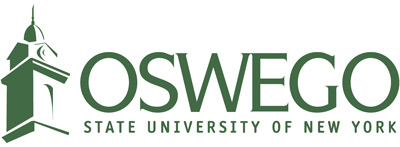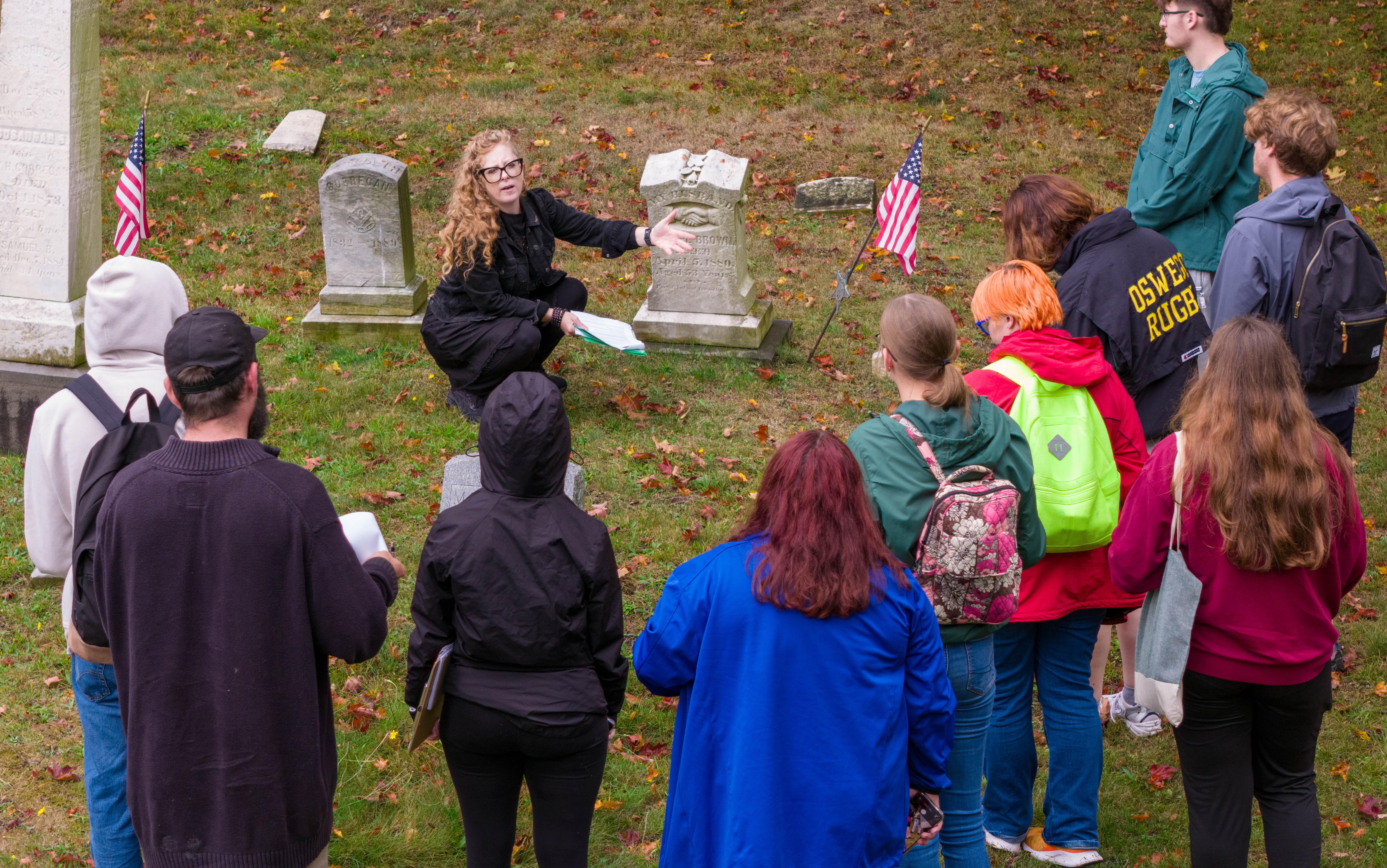The humanities are alive and well at SUNY Oswego in the new School of Humanities –- part of the College of Liberal Arts, Sciences and Engineering -- joining past, present and future via storytelling and searching for solutions. Here Candis Haak, a history faculty member and director of the new humanities school, teaches her “Death, Data and Local Cemeteries” course at Riverside Cemetery recently.
SUNY Oswego’s new School of Humanities –- part of the College of Liberal Arts, Sciences and Engineering (CLASE) –- is connected by storytelling, searching and solutions, said Candis Haak, the inaugural director of the school.
“It’s always the humanities that can help us the most in finding solutions to the big problems that are affecting us,” Haak noted.
The School of Humanities encompasses the departments of English and Creative Writing, History, Modern Languages and Literatures, and Philosophy, with Haak noting they all contribute to well-rounded students and scholars.
“Philosophy helps you learn how to make good arguments, helps you become a master of the language,” Haak said. “It’s so versatile, as a standalone or complement to another major.”
She noted many philosophy graduates go to law school, having learned how to use language and reasoning, but that the degree has many other applications.
Haak is a history faculty member, and being in Oswego –- “so much history happened here” –- is a bonus to a degree that also teaches a lot.
“You have to know what’s happened before so you don’t make the same mistakes,” Haak said. “You also have to appreciate the world around you, the people who went before and to appreciate it.”
English and creative writing “is about storytelling in every capacity,” Haak said. “Their department is so energetic and so helpful. It’s about communicating ideas, and this is the strength it’s going to give people working with AI. All the humanities give you the ability for that.”
Many English majors also go on to earn their master’s from Oswego’s College of Education, Health and Human Services, to enter the field of teaching. “All of these bundle very nicely for anyone who wants to get into education in any capacity,” Haak said.
Modern languages and literatures are valuable because the university is “creating global citizens and how better to do that than to communicate in other languages,” Haak explained. “It lets you become a global citizen and engage in other cultures in a meaningful way. Our study abroad programs change students’ lives. Going abroad, getting immersed in other cultures will change you for the better.”
Seeing and studying stories
Kristin Croyle, dean of CLASE, noted the importance of the humanities in critical thinking, telling stories and connecting communities.
“The humanities are interesting because they literally are ever-present in our lives, but if you look at public discourse they often are not,” Croyle said. “Yet they help us see the world around us, help us look backwards and forward, teach us how to write our own stories and read the stories of other people.”
As CLASE and its three new schools –- also including the School of Behavioral and Social Sciences and the School of Engineering –- all seek out ways to better connect with the region and the community, the charge to the School of the Humanities dovetails well.
“The humanities study what is in your region, what happened with important features like Lake Ontario and the Erie Canal,” Croyle said. “They give current students and the families in the region an appreciation for the history, and it’s exciting.”
History major Rory Kemp is an example of a student working in the humanities in an interdisciplinary way connecting with the local community. A student in Haak’s “Death, Data and Local Cemeteries” course, Kemp is learning about how cemeteries reveal a lot about lives, living and what people found important over the centuries.
The regional history is new to Kemp, who moved here from Oregon since his partner is originally from Fulton. With an ability to take classes via the Chapter 31 program as an active-duty Army member through the Veterans Administration, Kent quickly realized how much history exists in Central New York and how it impacts the world of today and tomorrow.
“Upon moving here and figuring out what I want to do, I came to realize what history means,” Kemp said. “I didn’t realize how many answers we can find today from studying history. I don’t think generally people think about history that way.”
Since the class started work at Riverside Cemetery in Oswego –- where university founder Edward Austin Sheldon, among many other important local figures, are buried –- Kemp took an interest in its related urban forestry, and how planting, maintenance and upkeep reflect what the living have found important over time.
Looking at gravestones all the way from back before Oswego was even a city, and the care and creativity put into them, contrasts with how cemeteries are not as much of a focus these days. “When stewardship is not as high a priority, it changes the way we view death,” Kemp said.
Kemp is using a tree survey conducted by Andrew Nelson, former director of the university’s Rice Creek Field Station, a Google Earth inventory from SUNY College of Environmental Forestry, and documents from local historians to get a holistic view of how the cemetery –- and humans’ interactions with it –- has changed over the years.
“I’m going to take that quantitative data and study it to see what kind of progress it’s made since the urban forest was created, and look at the cultural aspect of how we interact with cemeteries," Kent explained. “Being in nature in that way brings us closer to what can happen to us.”
The cemetery includes a silent witness to make of the region’s change in a Norway spruce that is around 310 years old. “It’s experienced a lot of change, climatically and with the things going on around it,” Kemp said. “It was a farm area, now it’s a cemetery. What that thing has weathered, we can’t even comprehend it.”
Connecting community
The research Kemp is conducting and will share with the community is just one example of the School of Humanities, and other academic partners, becoming more engrained locally in Oswego becoming more of a hometown university. Haak is exploring options with Alanna Ossa –- director of the School of Behavioral and Social Sciences and an anthropology faculty member –- in collaborating across disciplines in working with the community.
“What Alanna and I do is work with the communities, bring them into our discussion so they too can understand what’s going on with the humanities and our values,” Haak said. And English and creative writing students, for example, have taken on a number of projects bringing the value of words to support local communities and initiatives in the city of Oswego and beyond.
A first priority is to “create awareness of what the humanities are, how they’re related, how they connect all of us,” Haak said. She envisions “micro-events heavily run by students, which could include lightning talks, sharing what they’re doing in classes, how they’re building community.”
Haak is in the process of meeting with different student groups in these areas to mobilize these microevents, bringing together different parts of the humanities.
“We have so many people I can tap on the shoulder to be champions of the humanities as well,” Haak said. “The more I talk to people the more I see what I call these humanities champions.”
Haak also brings a background in the digital humanities, which makes research and data much more sharable and immediate, and is something that makes the work in the humanities and related field more lasting and relevant.
“More and more different departments are using storymaps in their classes, so more and more students are dipping their toes in and becoming digital storytellers,” Haak said.
“The digital humanities makes more things more accessible, as once it gets online, more people get access,” Haak added. “A big emphasis is asking: How do we share what we find with the community? Many of us host events in the community, so it’s about creating physical presence and digital presence.”
For students like Kemp, the lessons of the humanities and their role in communities and discourse, have become evident. The hope is that events and outreach will convince more students to pursue these valuable and versatile degrees.
“It’s been transformative for me,” Kemp said of his Oswego experience, particularly Haak’s class. “Even just in a month of classes, learning about Victorian symbolism, and the reported meanings for the symbols, you can’t help but reflect inwards. It makes me realize the way that I’m living. It really is a transformative class if you let it be. And she teaches with a really great energy, very passionate about her work.”
That work and passion for the humanities and local communities will just continue flourishing, Haak predicts.
“We have so much momentum and so many amazing people here, it’s just a matter of how we can best use our energies,” Haak said. “We have so much value, just looking at the amazing things we can do and the problems we can solve.”




